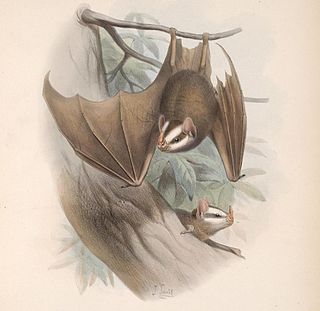
The New World leaf-nosed bats (Phyllostomidae) are found from southern North America to South America, specifically from the Southwest United States to northern Argentina. They are ecologically the most varied and diverse family within the order Chiroptera. Most species are insectivorous, but the phyllostomid bats include within their number true predatory species and frugivores. For example, the spectral bat, the largest bat in the Americas, eats vertebrate prey, including small, dove-sized birds. Members of this family have evolved to use food groups such as fruit, nectar, pollen, insects, frogs, other bats, and small vertebrates, and in the case of the vampire bats, even blood.

The Recife broad-nosed bat, is a species of bat from South America. It is named for the city of Recife in Brazil, where it was first recorded by Oldfield Thomas in 1901.

Chiroderma – big-eyed bats or white-lined bats – is a genus of leaf-nosed bat found in North America, Central America, and South America and the Lesser Antilles.
The Eldorado broad-nosed bat is a species of bat in the family Phyllostomidae. It is found in Guyana, Suriname, northern Brazil, and southern Venezuela.

The Choco broad-nosed bat is a species of bat in the family Phyllostomidae. It is native to Colombia, Panama, and Ecuador, where it is found in the Choco region lowlands. It is threatened by habitat loss. In 2013, Bat Conservation International listed this species as one of the 35 species of its worldwide priority list of conservation.

Thomas's broad-nosed bat is a species of bat in the family Phyllostomidae. It is found in Bolivia, Colombia, Ecuador, Panama, and Peru.

The shadowy broad-nosed bat is a species of bat in the family Phyllostomidae. It is found in Colombia and Venezuela.

The greater broad-nosed bat is a species of bat in the family Phyllostomidae. It is found in Bolivia, Colombia, Costa Rica, Ecuador, Panama, Peru, and Venezuela.

The lesser yellow-shouldered bat is a species of bat in the family Phyllostomidae. It is native to Peru and Ecuador. It is threatened by habitat loss.

Stenodermatinae is a large subfamily of bats in the family Phyllostomidae.
The slender broad-nosed bat is a species of bat in the family Phyllostomidae. As a phyllostomid bat, it is characterized by a narrow uropatagium which is fringed with hair; a white dorsal stripe; large inner upper incisors convergent at the tips; and three upper and three lower molars. It is found in eastern Colombia and Ecuador, north-eastern Peru, and Venezuela. It is closely related to Platyrrhinus incarum and Platyrrhinus fusciventris.

The brown-bellied broad-nosed bat is a species of bat in the family Phyllostomidae. As a phyllostomid bat, it is characterized by a narrow uropatagium which is fringed with hair; a white dorsal stripe; large inner upper incisors convergent at the tips; and three upper and three lower molars. It is found in Guyana, Suriname, French Guiana, Trinidad and Tobago, northern Brazil, eastern Ecuador, and southern Venezuela. It is closely related to Platyrrhinus incarum and Platyrrhinus angustirostris.

The Matapalo broad-nosed bat is a species of leaf-nosed bat described in 2005. It is found in South America.

Platyrrhinus ismaeli is a species of bat found in South America.

Kalko's round-eared bat is a species of leaf-nosed bat endemic to Panama.

Platyrrhinus albericoi is a species of leaf-nosed bat found in South America.
The Quechua broad-nosed bat is a species of bat in the family Phyllostomidae. It is found in Bolivia and Peru.
The western broad-nosed bat is a species of bat in the family Phyllostomidae. It is found in Colombia and Ecuador.













